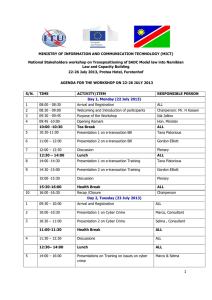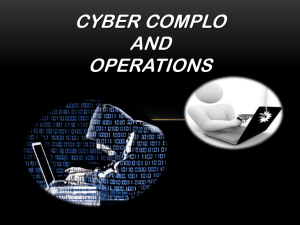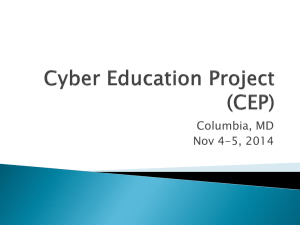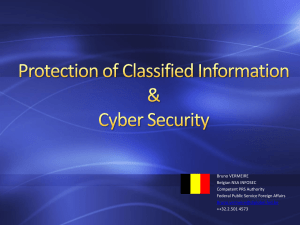Information Security Awareness and Training Program: Taking your
advertisement
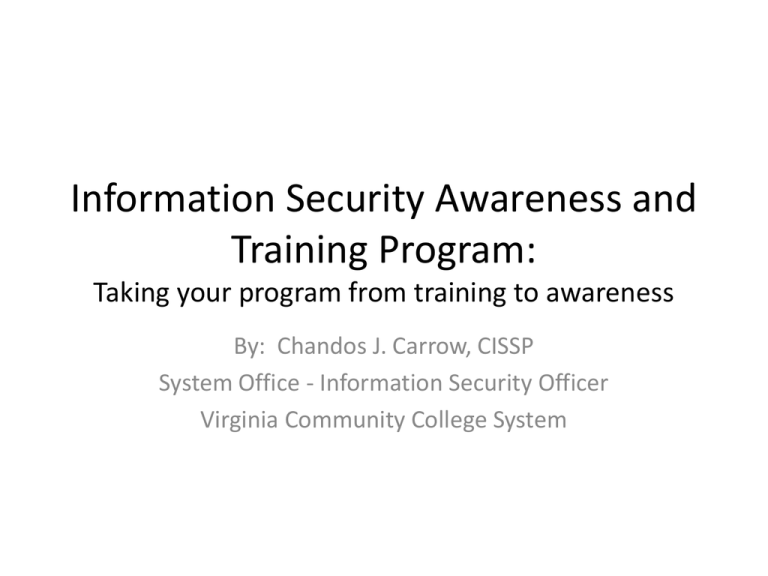
Information Security Awareness and Training Program: Taking your program from training to awareness By: Chandos J. Carrow, CISSP System Office - Information Security Officer Virginia Community College System Question • Why is October important for Information Security Awareness and Training? • October is National Cyber Security Awareness Month • Started 10 years ago • Sponsored by Department of Homeland Security in cooperation with the National Cyber Security Alliance and the Multi-State Information Sharing and Analysis Center Basic Information Security Awareness and Training Program • Four level approach: – Awareness • Designed to be presented to all users to focus their attention on security • Intended to allow individuals to recognize IT security concerns and respond accordingly – Training • Strives to produce relevant and needed security skills and competencies • Builds upon the information gathered from awareness presentations – Education • Integrates all of the security skills and competencies of the various functional specialties into a common body of knowledge • Strives to produce IT security specialists and professionals capable of vision and proactive response – Professional Development • Intended to ensure that users possess a required level of knowledge and competence necessary for their roles • Validation of skills typically through certification Where Do Companies Go Wrong • The Information Security Awareness and Training program was thrown together to meet a requirement • No planning went into the implementation • There was no specific budget provided • Mostly considered an IT Security issue and not very well supported in other departments • No one is designated as the program administrator or is typically assigned to someone as an additional duty • Program only consists of an annual presentation that users review and there is nothing throughout the rest of the year to reinforce what they were presented Awareness VS Training • In order to have a good Information Security Awareness and Training program you must have a great foundation • Awareness is that foundation • An annual presentation is a great start to awareness, but without constant reinforcement that information obtained by users will not set in • Training should focus more on the specifics of your company and the systems you use, and it does not supersede awareness for any position Creating/Redesigning an Information Security Awareness and Training Program • Many companies already have a program, but the steps for creating a new program can be used to redesign your current program as well 1. Ensure you have upper management support a. b. 2. Resources Commitment Create an Information Security Awareness and Training program team a. b. c. d. Most influential members of each department Members should be dedicated to the cause and will be active participants Do not have to be technically/security savvy to be part of the team If team members are not active, they are reported to management and a replacement requested 3. Define the roles and responsibilities that each person/department will play within this program a. Create policies, standards, guidelines, and procedures 4. Determine what type of program management model you will use for your company a. Centralized, Partially Decentralized, or Fully Decentralized 5. Conduct a Needs Assessment a. Complete interviews, surveys, review resource material, etc. 6. Have a clear mission and directives 7. Listen and analyze the user feedback 8. Determine where are the gaps between what is currently being done and what is required 9. Explore your options for deploying your program a. Company generated material, third-party generated material hosted on internal Learning Management System (LMS), or third-party hosted solution 10.Develop the strategy and plan of the program a. Current regulations, scope, goals, target audience, learning objectives, topics, mandatory/optional courses, evidence of learning, frequency 11. Implementation Schedule a. Establish your priorities especially if this implementation is to be done in a phased approach 1. 2. 3. 4. Availability of material/resources Role and organizational impact State of current compliance Critical project dependencies 12. Setting the bar a. Determine the complexity of the material presented based on the target audience 13. Funding the program a. b. c. d. Percent of overall training budget Allocation per user by role Percent of overall IT budget Explicit dollar allocation by component based on overall implementation costs Delivering Awareness Materials • Messages on awareness tools – Pens, key fobs, notepads, bookmarks, etc. • Posters • Screensavers • Popup messages when people log into their computers • Newsletters • Company wide e-mail messages • • • • Videotapes (YouTube videos) Web-based sessions IT security days Changing the IT security webpage – Current awareness theme – Helpful information and tips • • • • • • “Brown bag” seminars Mascots Crossword puzzles and other games Award program Do and Don’t list In-person instructor-led sessions Keeping Your Program Up-to-date • A program is never complete – Always listen for and read about new threats – Policies and standards do change • Always be open for feedback from users – The program is designed for them – If they do not like it then they will not take it seriously • On at least a semi-annual basis the team should review the materials and presentations of the program – If materials/presentations come from a third-party then they should have some review/update process • • • • • • • • Surveys Benchmarking Technology Shifts Focus Groups Interviews Status Reports Independent Observations Evaluation Forms Success Indicators • Sufficient funding to implement the agreed-upon strategy • Appropriate organization placement to enable those with key responsibilities to effectively implement the strategy • Support for broad distribution and posting of security awareness items • Executive/senior level messages to staff regarding security • Use of metrics – Decline in security incidents or violations, gap between existing awareness and training coverage and identified needs is shrinking, etc. • Managers do not use their status in the organization to avoid security controls • Increase in the level of attendance at mandatory security forums/briefings • Recognition of security contributions • Motivation is demonstrated by those playing key roles in managing/coordinating the security program Helpful Tips • Keep your awareness material interesting and up-to-date • Repeating an awareness message and using different ways to present that information will increase the retention by the users • Make sure that the delivery of the awareness material is easy to use and understand, is scalable, and does not impact the work production of the users • Deliver updates on a monthly/quarterly basis to your Senior Leadership and/or Board of Directors • After implementation of the program, continue having at least monthly meetings of your team because a program is never finished it should be continually modified to meet the needs of your company and addresses the new threats on cyber security Resources • http://infosecresources.com/security-awareness.html Questions Thank You Contact info: Chandos Carrow ccarrow@vccs.edu


